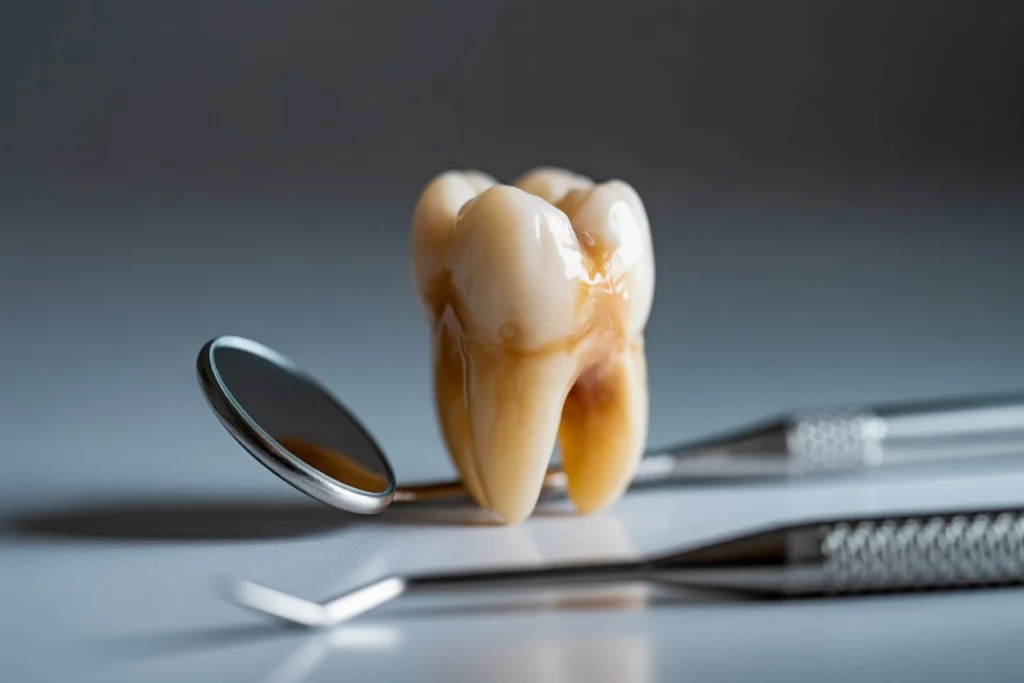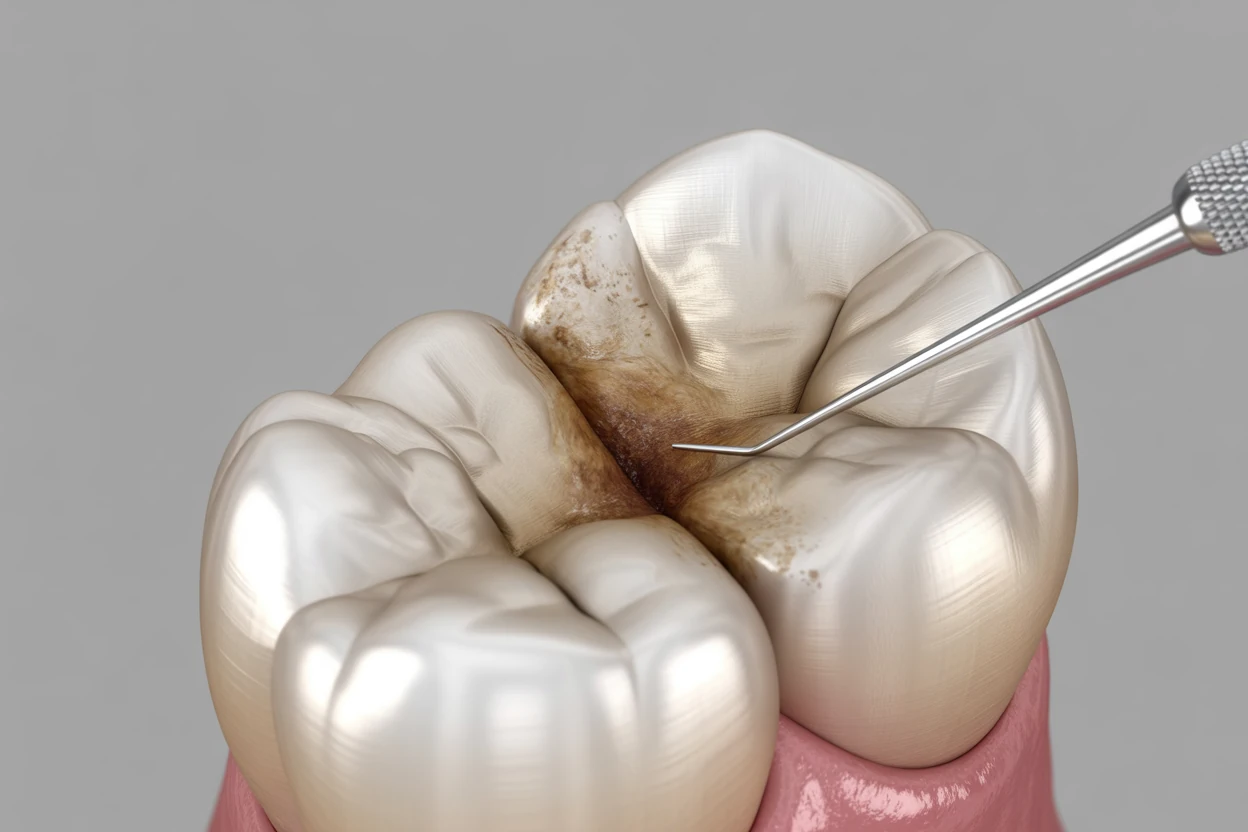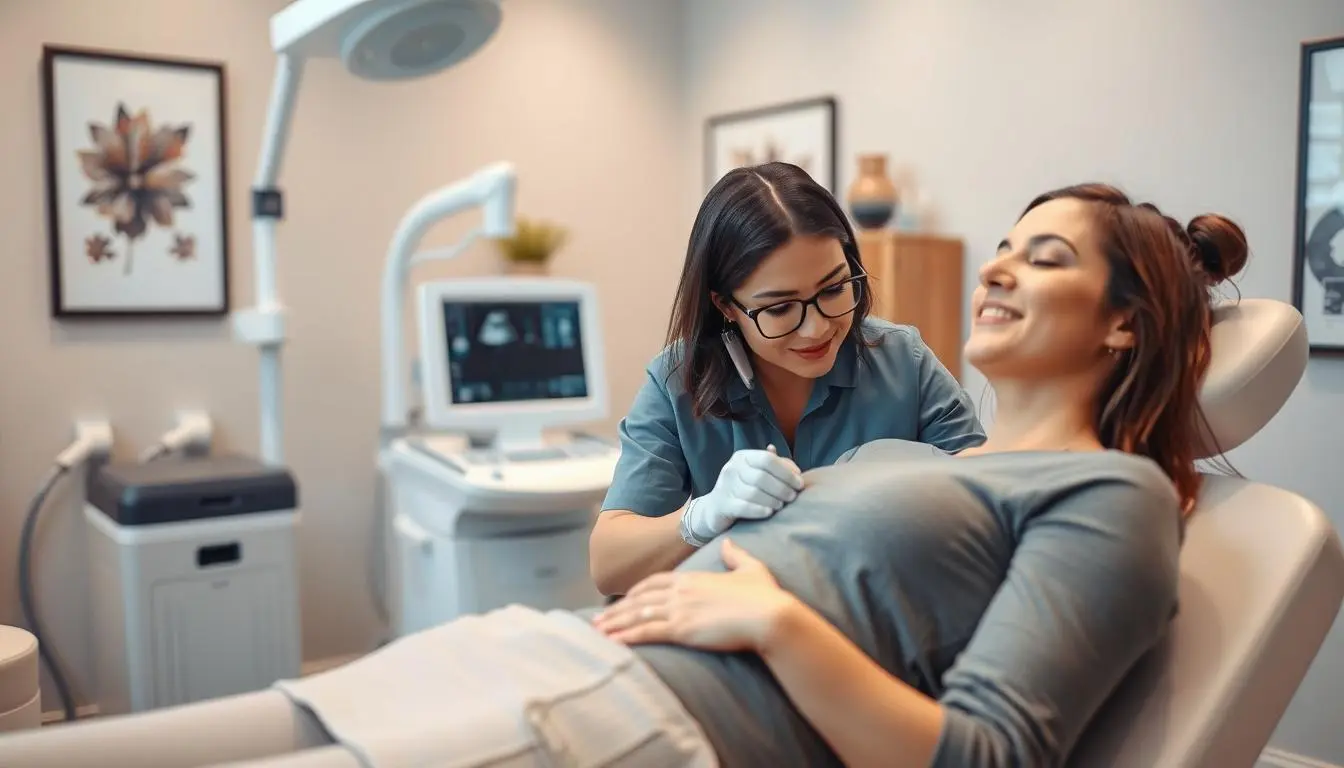A Stage 1 early cavity is kind of like that tiny crack in your phone screen — you notice it if you look closely, but it’s easy to ignore because, well, it’s not “broken” yet. Except teeth don’t magically heal the way we wish they would. In this first stage, what’s happening is the enamel — that hard outer shell you never really think about — is starting to lose minerals. It’s the earliest point in the tooth decay process, right before things start heading into irreversible territory.
Here’s the thing: catching cavities between teeth at this stage can save you a lot. Not just money or dental visits, but the whole ordeal of a filling or even a root canal down the road. It’s prevention in its truest form.
This guide will walk you through the signs, how dentists confirm it, treatment options that can stop it in its tracks, and some prevention tips you can stick with. Think of it less like a lecture and more like a friendly roadmap from “huh, that’s odd” to “crisis averted.”
1. What is a Stage 1 Early Cavity?

You’ve probably heard dentists throw around terms like “incipient caries” or “demineralization.” It sounds clinical, but the concept is simple: in a Stage 1 early cavity, the outer layer of your tooth — the enamel — starts losing minerals faster than your saliva and fluoride can put them back. It’s the very first step toward a full-blown cavity, but here’s the hopeful part: at this stage, the damage is still reversible.
Think of your tooth as a three-layer cake. First, there’s the enamel (thin, glassy, strong). Beneath that, the dentin (more sensitive, softer). And finally, the pulp, where the nerves and blood supply live. A Stage 1 cavity lives exclusively in that enamel layer. No drilling. No nerve pain. And yet, if you ignore it, it will push deeper — and once it reaches dentin, you can’t reverse it.
Pro Tip: If your dentist mentions “demineralization” during a check-up, ask them about remineralization strategies instead of assuming a filling is your only option.
Is a Stage 1 cavity reversible?
Yes — and that’s the beauty of this stage. With proper oral hygiene, fluoride toothpaste, and sometimes professional fluoride treatments, the enamel can reabsorb minerals and seal itself back up, no drilling required. But timing matters… wait too long, and it won’t be an option.
2. Common Signs & Symptoms of a Stage 1 Cavity

The frustrating thing about a Stage 1 early cavity is… You can walk around with one and have no clue. There’s no throbbing tooth pain, no obvious hole — just these small, almost sneaky hints.
Here’s what people (including me, once) usually notice first:
- White or chalky spots on the tooth enamel — almost like someone dabbed a bit of matte paint on an otherwise shiny surface.
- Mild tooth sensitivity when you drink iced water, sip coffee, soft drinks or bite into something sweet.
- A faint roughness when you run your tongue over the tooth surface — like it’s just not as smooth as the others.
- Absolutely no pain — which is exactly why so many ignore it, thinking it’s nothing.
Honestly, that last one is the trap. Pain usually shows up once the decay has already burrowed into the dentin layer. By then, you’re in dental filling or even root canal territory.
Pro Tip: If you’ve noticed white spots on teeth, don’t just chalk it up to “normal.” In dental health terms, that’s often the earliest visible sign of enamel decay.
Can you see a Stage 1 cavity in the mirror?
Sometimes. If it’s on a front tooth and you have good lighting, you might catch that white spot lesion. But cavities between teeth, or on back molars, are nearly impossible to spot without a dental mirror and a bright light. That’s why regular dental check-ups (yes, even when nothing hurts) are worth their weight in gold fillings… Well, maybe not literally.
3. How Dentists Diagnose Early Cavities?

When you finally sit in the dental chair — hopefully before the cavity has advanced — your dentist has a few tricks up their sleeve for cavity detection. It’s not all about X-rays (though those matter too).
Here’s a quick breakdown:
| Method | What It Is | Why It Works |
| Visual Exam | Using bright light and magnification to spot enamel discoloration or roughness. | Great for surface cavities and white spot lesions. |
| Dental Explorer | A fine metal tool that gently checks for soft spots or rough edges. | Can detect early enamel decay without damaging the tooth surface if used gently. |
| Bitewing X-rays | Digital X-rays that reveal decay between teeth. | Essential for spotting cavities in hard-to-see places. |
| Laser Fluorescence (DIAGNOdent) | A device that measures changes in tooth structure with light. | Highly sensitive for detecting early cavity formation before it’s visible. |
How often should you get dental X-rays?
For most people with good oral hygiene and no history of rapid cavity formation, every 1–2 years is enough. But if you’re cavity-prone (maybe you snack often on sugary foods or have a dry mouth), your dentist might recommend annual digital X-rays.
And here’s the part a lot of people forget — a good dental hygienist or pediatric dentist often spots the early trouble long before you feel anything. That’s why skipping those dental appointments isn’t saving you money; it’s just delaying the bill.
4. Causes & Risk Factors
A Stage 1 early cavity doesn’t just appear out of nowhere. It’s the result of a chain reaction — one that starts small but keeps going unless you interrupt it. And sometimes, even if you brush twice a day, things can still slip through.
Here’s the usual tooth decay process in real-life terms:
- Plaque bacteria (the sticky film you feel if you skip brushing) settle in.
- These bacteria feed on sugary foods and refined carbs, releasing acids.
- Those acids slowly dissolve tooth enamel, causing acid erosion and creating weak spots.
- If the enamel isn’t remineralized, you get an early cavity — the first step toward dentin involvement and, later, possible root canal therapy or even a dental crown.
Major risk factors for enamel decay:
- Frequent snacking or sipping sugary or acidic drinks (even “healthy” citrus juices).
- Poor oral hygiene — irregular brushing, skipping flossing, or rushing the process.
- Dry mouth (low saliva flow) can be caused by medications, dehydration, or certain health conditions.
- The enamel is already weakened by previous acid erosion or tooth discoloration.
- Not using fluoride toothpaste or avoiding fluoride treatments entirely.
Pro Tip: If you think you’re doing everything right but still get cavities, ask your dental healthcare professional about a fluoride gel routine or even dental sealants for extra protection. Sometimes, prevention needs a little backup.
Can you get cavities even if you brush regularly?
Yes. If your brushing technique misses areas, if you snack often, or if you have high plaque bacteria activity, decay can still form. That’s why flossing, fluoride mouthwash, and limiting sugar exposure are just as important as brushing.
5. Can a Stage 1 Cavity Heal Itself?

This is the question everyone asks — and the answer is cautiously optimistic: sometimes. A Stage 1 early cavity is actually in the demineralization phase, meaning the tooth’s enamel is losing minerals but hasn’t yet broken through into a permanent hole. With the right conditions, this process can be reversed through remineralization.
How remineralization works:
- Saliva naturally carries minerals like calcium and phosphate to rebuild weakened enamel.
- Fluoride treatments (varnish, gel, or even fluoride toothpaste) help integrate fluoride into the enamel structure, making it more resistant to plaque acids.
- Diet changes — reducing sugary snacks and increasing tooth-friendly super foods — give your enamel a better fighting chance.
| Remineralization Boosters | Why They Help |
| Fluoride Toothpaste | Strengthens enamel and resists acid erosion. |
| Fluoride Varnish / Gel | Higher concentration for targeted enamel repair. |
| Calcium & Phosphate (CPP-ACP products) | Replaces lost minerals in the enamel. |
| Xylitol Gum | Stimulates saliva flow and reduces harmful bacteria. |
How long does it take for an early cavity to reverse?
It depends. With consistent dental hygiene and preventive measures, remineralization can happen in a few weeks to several months. But — and this is the part people skip over — once the enamel surface breaks, you’re in dental filling territory. No amount of fluoride toothpaste will rebuild a hole.
6. Treatment Options for Stage 1 Cavities
The good news? If your dentist catches a Stage 1 early cavity, you’re not headed for the drill — at least not yet. Treatments at this stage are focused on stopping enamel decay and giving your teeth a fighting chance to repair themselves.
Here are the most common approaches dentists use:
1. Professional Fluoride Treatment
This can be a varnish, gel, or foam applied during a dental check-up. Higher strength than store-bought toothpaste, it helps remineralize weakened tooth enamel and stop cavity formation.
2. Dental Sealants
A thin protective coating (often used on molars) that seals the tooth surface, preventing plaque bacteria and acids from settling in. Especially common in pediatric dentistry, but adults at high risk can benefit too.
3. Remineralizing Agents
Products containing CPP-ACP (casein phosphopeptide-amorphous calcium phosphate) or hydroxyapatite can repair early enamel damage. Sometimes used alongside a fluoride toothpaste for a double defense.
4. Dietary Adjustments & Home Care
Limiting sugary foods and acidic drinks, and increasing tooth-friendly foods (like cheese, leafy greens, and almonds). Drinking more water to wash away plaque acids between meals.
Pro Tip: Ask your dental healthcare professional whether combining a fluoride varnish with a fluoride mouthwash might give you the best chance of reversing an early cavity, especially if your dental x-rays show multiple spots of demineralization.
Does insurance cover early cavity treatments?
Often, yes — especially for preventive care like fluoride varnish or sealants. Check with your provider, since coverage can vary, and some only pay for sealants in younger patients.
7. Daily Habits to Reverse or Prevent Stage 1 Cavities
You can get the best preventive dentistry treatment in the world, but if your daily routine is a mess, cavity detection will keep turning up new trouble spots. The habits that protect you from a Stage 1 early cavity aren’t complicated, but consistency matters more than perfection.
Core daily habits for strong enamel:
- Brush twice a day for at least two minutes with a fluoride toothpaste. Use a soft-bristled brush to avoid tooth surface wear.
- Floss once a day — it removes dental plaque where your brush can’t reach.
- Rinse with fluoride mouthwash in the evening to strengthen enamel overnight.
- Drink water after meals to dilute acids and wash away food particles.
- Limit frequent snacking — every snack triggers another acid attack.
Comparing Toothpaste Types for Early Cavities
| Toothpaste Type | Main Benefit | Best For |
| Standard Fluoride Toothpaste | Every day, enamel protection | Most adults & kids |
| High-Fluoride Prescription Paste | Extra-strength remineralization | High cavity risk patients |
| Hydroxyapatite Toothpaste | Enamel repair alternative to fluoride | Those avoiding fluoride |
| Whitening Toothpaste | Stain removal | Not ideal for active cavities (can be abrasive) |
Pro Tip: If you have tooth sensitivity or recurring dental caries, try brushing before breakfast instead of after. This reduces acid erosion from brushing on softened enamel caused by acidic foods.
What’s the best toothpaste for early cavities?
A standard fluoride toothpaste (1,000–1,500 ppm fluoride) works for most. If you have a history of enamel decay, your dentist may prescribe a high-fluoride paste or recommend one with hydroxyapatite for daily use.
8. Diet & Nutrition for Cavity Prevention

A lot of people think a Stage 1 early cavity is all about brushing and flossing — and, yes, those are crucial — but your diet is like the silent partner in your oral health journey. What you eat (and how often you eat it) can either help remineralize enamel or quietly feed the plaque bacteria that start the tooth decay process.
Tooth-friendly foods that protect enamel:
- Cheese & yogurt – High in calcium and phosphate, which strengthen tooth enamel.
- Leafy greens & almonds – Nutrient-dense and low in sugary foods.
- Fatty fish – Packed with vitamin D, which helps your body use calcium.
- Green & black tea – Contains polyphenols that can reduce plaque bacteria.
Foods & drinks to limit:
- Sugary snacks (cookies, candies, sweetened cereals).
- Acidic drinks (drink sodas, citrus juices, sports drinks).
- Sticky foods (dried fruits, caramel) that cling to tooth surfaces.
Pro Tip: If you can’t brush after a snack, drink water or chew xylitol gum to boost saliva flow and neutralize plaque acids.
Are sugar-free candies safe for your teeth?
They’re better than regular candy, but still check the label. Some sugar-free products contain acids for flavoring, which can still cause acid erosion and lead to enamel decay.
Diet and Cavity Risk
| Food/Drink | Impact on Teeth | Risk Level |
| Cheese | Increases saliva, adds minerals | Low |
| Citrus Juice | Acidic, can erode enamel | High |
| Water | Rinses away acids, neutral pH | Low |
| Sticky Candy | Prolonged sugar exposure | Very High |
| Green Tea | Anti-bacterial compounds | Low |
9. Myths About Early Cavities
When it comes to Stage 1 early cavity prevention, there’s no shortage of myths floating around — some harmless, some risky for your dental health.
Common myths and the truth behind them:
- “If it doesn’t hurt, it’s not a cavity.”
- False. Pain usually means the decay has reached the dentin layer or even the pulp. Cavity detection should happen before symptoms appear.
- False. Pain usually means the decay has reached the dentin layer or even the pulp. Cavity detection should happen before symptoms appear.
- “Baby teeth don’t matter because they fall out anyway.”
- Also false. Untreated dental caries in baby teeth can cause tooth loss earlier than necessary, affect speech, and even harm incoming adult teeth.
- Also false. Untreated dental caries in baby teeth can cause tooth loss earlier than necessary, affect speech, and even harm incoming adult teeth.
- “Natural remedies can replace dental care.”
- Partially true. Things like oil pulling or green tea can help reduce plaque bacteria, but they can’t reverse enamel decay once the surface has broken.
- Partially true. Things like oil pulling or green tea can help reduce plaque bacteria, but they can’t reverse enamel decay once the surface has broken.
- “You can’t get cavities if you brush regularly.”
- Not quite. Even with daily brushing, poor flossing technique, frequent snacking, and tartar buildup can still lead to dental problems.
- Not quite. Even with daily brushing, poor flossing technique, frequent snacking, and tartar buildup can still lead to dental problems.
Pro Tip: If you read something online about a “miracle cure” for cavities, check whether it’s backed by a dental healthcare professional or an actual clinical study. Anecdotes aren’t the same as evidence.
Can oil pulling cure cavities?
No — it may reduce bacteria and improve oral hygiene, but once a cavity has formed, only remineralization (for very early cases) or restorative treatments like a dental filling can fix it.
10. When to See a Dentist?
If you’re waiting for tooth pain before booking an appointment, you’re already too late in the tooth decay process. A Stage 1 early cavity is best handled long before discomfort appears — ideally spotted during dental check-ups or routine cavity detection.
When to schedule a visit:
- Every 6 months, for preventive measures like fluoride treatments and dental sealants.
- Immediately, if you see white spots on teeth, notice tooth sensitivity, or feel roughness on a tooth surface.
- Sooner if you have dry mouth, are prone to plaque bacteria buildup, or snack frequently on sugary foods.
Why early intervention matters:
| Stage of Decay | Treatment Needed | Cost & Complexity |
| Stage 1 Early Cavity | Remineralization, fluoride varnish | Low |
| Stage 2 (Dentin Involvement) | Dental filling | Moderate |
| Stage 3 (Pulp Involvement) | Root canal therapy, dental crown | High |
| Stage 4 (Advanced Decay/Abscess) | Extraction, dental implant | Very High |
Pro Tip: Even if you feel fine, small dental problems can snowball. Early dental appointments cost less, hurt less, and often avoid invasive procedures like root canal therapy or dental surgery.
Should you visit the dentist even without symptoms?
Absolutely. A dentist can spot enamel decay, dental plaque, and acid erosion long before you can — and prevent tooth loss or systemic infection down the road.
Conclusion
A Stage 1 early cavity isn’t a crisis — it’s a warning sign. The kind that says, “Hey, you’ve still got time to fix this… but not forever.” Whether it’s fluoride toothpaste, diet changes, or regular dental check-ups, the small habits you build now will decide whether you keep your enamel intact or end up needing restorative dentistry later.
Catching dental cavities in this first phase is your best chance to avoid dental fillings, dental crowns, or even a dental implant. And while no one loves sitting in the dental chair, a quick exam now is far easier than a root canal therapy or oral surgery later.
So maybe this week, book that check-up. Swap one soda for water. Floss before bed. They’re small steps, but they matter. Your future self — chewing happily, pain-free — will thank you.
Frequently Asked Questions
1. Can a Stage 1 early cavity go away on its own?
A Stage 1 early cavity can remineralize with fluoride toothpaste, good oral hygiene, and sometimes a professional fluoride treatment. Leave it untreated, and it will progress into the dentin, requiring a dental filling.
2. How can I tell if I have an early cavity?
You might notice white spots on teeth, slight tooth sensitivity to hot, cold, or sweet foods, or a subtle rough patch on a tooth surface. But here’s the thing — you often can’t see it in the mirror, which is why regular dental check-ups matter.
3. Does a Stage 1 cavity hurt?
Usually, no. Pain comes later when decay reaches the dentin or pulp. That’s why people often skip treatment, and why cavity detection at your dentist is so important.
4. How do dentists fix Stage 1 cavities?
Dentists typically use fluoride varnish, dental sealants, or remineralizing agents to stop enamel decay. No drilling is needed if it’s caught early, which is the whole point of preventive care.
5. How long does it take to reverse an early cavity?
Anywhere from a few weeks to several months. The timeline depends on your oral hygiene habits, diet, and whether you’re using fluoride treatments consistently.
6. Can kids get Stage 1 cavities too?
Absolutely. Pediatric dentists often see early cavities in children, especially if they snack frequently or drink sweetened drinks. Baby teeth matter, so early dental appointments are key.
7. Are there any home remedies for Stage 1 cavities?
You can support remineralization at home with fluoride toothpaste, xylitol gum, and a sugar-free diet, but home care works best alongside professional guidance from a dental healthcare professional.
8. Does insurance cover Stage 1 cavity treatment?
In many cases, yes — especially for preventive treatments like fluoride varnish or dental sealants. Coverage varies, so check with your provider.
9. What happens if I ignore an early cavity?
It progresses into deeper tooth decay, eventually requiring a dental filling, root canal therapy, or even a dental crown or dental implant if the damage is severe.
10. How can I prevent Stage 1 cavities in the first place?
Brush twice daily with fluoride toothpaste, floss once a day, limit sugary foods, drink plenty of water, and keep up with dental check-ups. It’s all about prevention — way easier than treatment.



